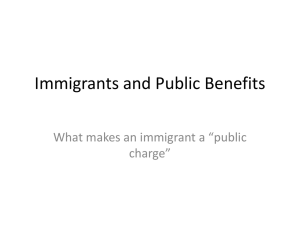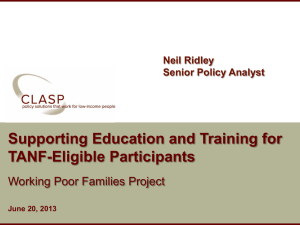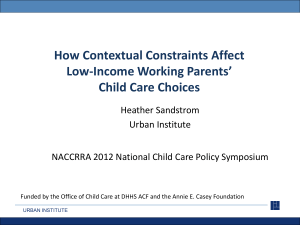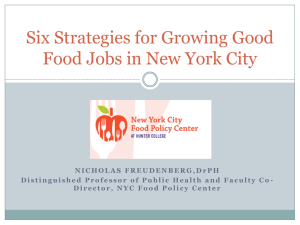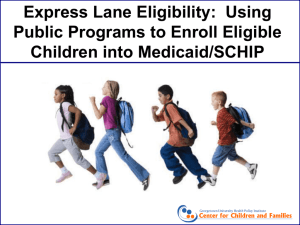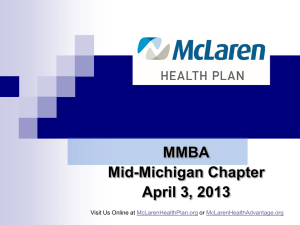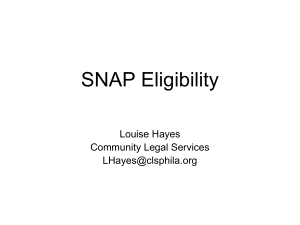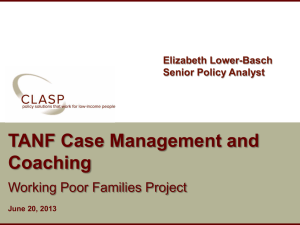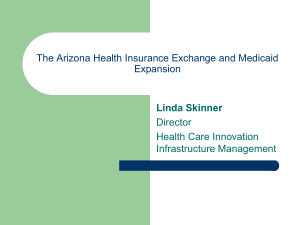Integrating Public Benefits into Campus Services
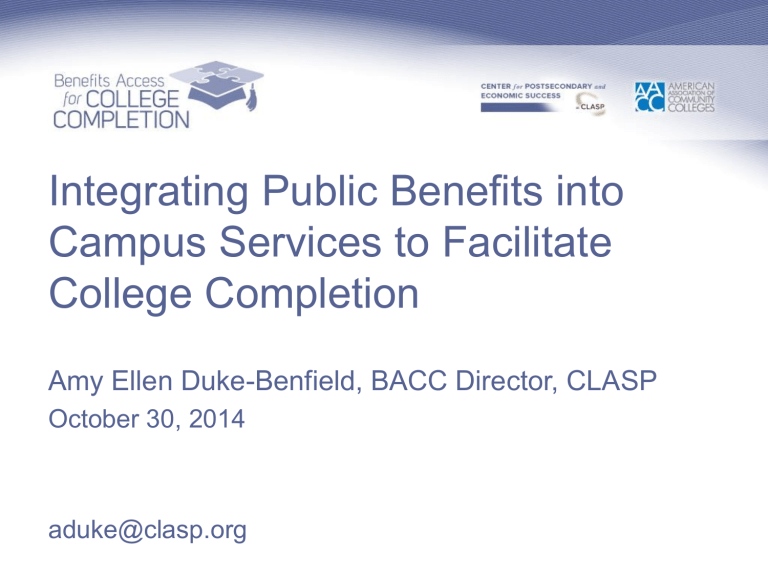
Integrating Public Benefits into
Campus Services to Facilitate
College Completion
Amy Ellen Duke-Benfield, BACC Director, CLASP
October 30, 2014 aduke@clasp.org
CLASP and the Center for
Postsecondary and Economic Success
•
Through careful research and analysis and effective advocacy , CLASP develops and promotes new ideas, mobilizes others, and directly assists governments and advocates to put in place successful strategies that deliver results that matter to people across America.
•
C-PES advocates for better policies , more investment , and increased political will to increase the number of low-income adults and disadvantaged youth who earn postsecondary credentials that are essential to opening doors to good jobs, career advancement, and economic mobility.
3
Who are colleges serving?
Yesterday’s Nontraditional Student
Is Today’s Traditional Student
47%
Independent
23%
Parents
32%
Employed
Full-Time
40% of all students are low-income
4
What are the statistics?
Among community college students:
•
40% do not complete any degree in 6 years and are not enrolled
•
31% receive financial aid
•
50% have unmet need after financial aid
Among all students:
•
66% the proportion of the cost of attendance left after tuition, fees and books
•
71% said they dropped out to go to make money
5
Why holistic support?
6
Reasons for Leaving School
Hypothesis
Providing students who are struggling to make ends meet with information about public benefits and assistance in applying for them will improve student success and college completion rates and reduce material hardship .
7
Benefits Access for College
Completion
•
An initiative geared toward increasing access to public benefits for community college students
•
Supporting colleges developing sustainable models that build benefits access into the everyday activities across the college
•
BACC is a partnership between CLASP, the
American Association of Community Colleges and five foundations
8
Participating Colleges
•
Cuyahoga Community College (OH)
•
Gateway Community and Technical College (KY)
•
LaGuardia Community College (NY)
•
Lake Michigan College (MI)
•
Macomb Community College (MI)
•
Northampton Community College (PA)
•
Skyline College (CA)
9
What are “ public benefits ” ?
•
Supplemental Nutrition Assistance Program (SNAP)
•
Health insurance (Medicaid and CHIP)
•
Family programs
TANF, child care subsidies, Women, Infants and Children
(WIC) food and formula, free and reduced school lunch
•
Refundable Tax Credits
Earned Income Tax Credit (EITC) & American Opportunity
Tax Credit (AOTC)
•
Special programs
Disability benefits, Veterans benefits, UI, TAA, WIA ITAs and other supports
10
Why don’t more students access benefits?
•
Lack of information, misinformation about eligibility
Don ’ t know that programs exist
Think they are not eligible
Do not know how to apply or where to get help
Feel the benefit is not worth the hassle
Do not see themselves as target for public benefit programs
•
Applying is often time consuming, frustrating
Same information collected multiple times
Need documentation of income, family status
•
Stigma and other social/cultural barriers
12
Low-Income Parents
•
Eligible for wide range of programs
–
Some programs are limited to families with children
–
Others are open to childless adults, but are more generous or have fewer restrictions for parents
•
Few receive all programs they are eligible for:
–
Some programs have capped funding
–
Eligible individuals may not know about programs, or may be deterred by the burden of establishing and maintaining eligibility
13
Low-Income Parents
Likely to receive (> 80%)
•
EITC
•
Health insurance for kids
(and parents in expansion states)
Probably receive (50-80%)
•
Health insurance for parents (not expansion states)
•
SNAP (Food Stamps) and WIC
Might receive (<50%)
•
TANF, child care subsidies, housing subsidies
14
Low-Income Childless Adults
(no disability)
Probably receive (50-80%)
•
EITC
–
Only eligible if aged 25-64
– max of $496 per year
•
SNAP (Food Stamps)
–
Students are subject to extra rules
Might receive (<50%)
•
Housing subsidies
•
Public health insurance (depends upon if reside in expansion state)
News Flash: Health Exchanges and
Medicaid Eligibility Changes in 2014
•
Beginning January 1, 2014, many states expanded
Medicaid to all non-elderly adults and children up to
133% of the federal poverty level
$14,484 for an individual
$29,725 for a family of four
•
Enrollment for the health insurance exchanges and Medicaid expansion fully online
16
28 States Are Expanding Medicaid
How are Colleges Helping Students
Access Public Benefits?
•
Inform students about the existence of programs
•
Help students understand how to apply
•
Screen students to determine if they are eligible and assist them to apply
•
Assist students to provide needed documentation and understand any barriers to eligibility
•
Follow-up with benefits programs/local offices to troubleshoot on behalf of individual students
•
Advocate for policy changes that streamline benefits receipt for students
BACC College Strategy Highlights
•
Engage a broad-based team to embed activities across college
•
Cultivate leadership
•
Develop a process for engaging students that includes:
Reaching out to students in multiple ways
Setting up places to apply depending on student needs
Helping students apply and submit documentation
Providing follow-up assistance to ensure students receive benefits
18
BACC College Strategy Highlights
•
Use data to identify students, target services or activities, and continuously improve
•
Integrate benefits discussions/application into financial aid, career services, support services, advising and counseling processes
•
Integrate a module about benefits in orientation, student success courses, and other courses
•
Use students to help market, do outreach, and serve students
•
Where available, use online eligibility screeners and online applications to assist students
19
Online Access to Public Benefits
•
Virtually all states have made basic program info for the five state-administered, low-income benefit programs available online:
–
SNAP, CHIP, Medicaid, TANF, and child care assistance
•
Many states go further, providing application forms and allowing individuals to apply online
Getting Started
•
Identify the need on your campus
•
Seek buy-in from leadership
•
Seek out individuals on campus and in the community already doing this work
•
Identify existing resources in your state or county that could help students (i.e. online screening tools or applications)
•
Form a committed team
•
Create an action plan
21
Questions for Attendees
Do any of you provide benefits access on campus?
If not, have you noticed students expressing needs you can’t meet? What do you do in those cases?
